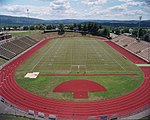Tri-State Zoological Park
Buildings and structures in Cumberland, MarylandCulture of Cumberland, MD-WV-PAMaryland building and structure stubsTourist attractions in Allegany County, MarylandZoo stubs ... and 2 more
Zoos established in 2003Zoos in Maryland
The Tri-State Zoological Park was a 16-acre (6.5 ha) zoo located in Cumberland, Maryland, United States. The nonprofit zoo opened in 2003, and contains mainly exotic animals rescued or in need of homes, including lions, tigers, primates, various exotics, birds and reptiles. The zoo was privately owned by Bob Candy of Cumberland and has no paid employees, run only by volunteers.In February, 2020, four years after beginning a legal battle, PETA forcibly removed three big cats from Tri-State Zoological Park to a facility in Colorado.The zoo was not accredited by the Association of Zoos and Aquariums.On October 2, 2022, the zoo permanently closed its doors.
Excerpt from the Wikipedia article Tri-State Zoological Park (License: CC BY-SA 3.0, Authors).Tri-State Zoological Park
Cottage Inn Lane Northeast,
Geographical coordinates (GPS) Address Nearby Places Show on map
Geographical coordinates (GPS)
| Latitude | Longitude |
|---|---|
| N 39.6636247 ° | E -78.7148692 ° |
Address
Cottage Inn Lane Northeast 10169
21502
Maryland, United States
Open on Google Maps




